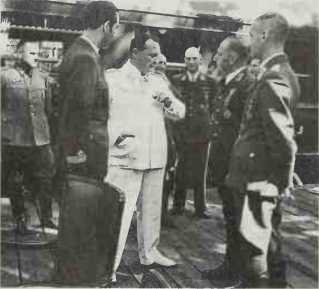Commanding a squadron of 4 British cruisers, 4 light cruisers and 16 destroyers, had an opportunity of engaging but did not as he had been ordered not to attack unless he had a superior force. The German ships reached Constantinople inflicting a serious blow to British and French naval prestige and giving encouragement to the proGerman “Young Turks”. ANF.
Golan Heights see arab-israeli
WARS.
Gold beach see normandy, invasion OF (1944).
Golikov, Col Gen Filip Ivanovich
(b. l900). Russian. Following commands in the invasions of Finland and Poland, 1939, Golikov led missions to Washington and London, negotiating Allied aid to Russia, in
1941. He was then head of gru and was instrumental in the recruitment of Western intellectuals — notably the Rosenbergs in the USA - to the communist cause. He was an army group commander in the Moscow counteroffensive,
1942, and at Stalingrad, 1942-43. A favourite of Kruschev, he was Deputy People’s Commissar of Defence and Chief of Personnel, Red Army, 1943-50.
Goltz, Field Marshal Freiherr Colmar von der (1843-1916). Ger. In 1883 Goltz was sent to Constantinople to reorganize the Turkish army along Prussian lines. At the beginning of World War I he was appointed Governor General of Occupied Belgium but in November 1914 returned to Constantinople as the Sultan’s “adjutant general”. Following Turkey’s entry into the war, he was given command of Sixth Army, leading it in a successful campaign against British forces in Mesopotamia. He died in Baghdad on April 29 1916, shortly before the British surrender at Kut. MS.
Gommecourt. Fortified village, attacked by the British 46th and 56th Divisions of Allenby’s Third Army, at heavy cost, on July 1 1916, as a diversionary operation in support of the main British Somme offensive farther south. The Germans held the village until their withdrawal to the Hinden-burg Line in 1917.
Goose Green. Largest settlement, with nearby Darwin, on East Falkland outside Port Stanley; scene of 2 Para’s assault, after several postponements, on May 28 1982. The attackers were heavily outnumbered by the reinforced elite Argentine 12th Regiment and surprise was compromised by a BBC World Service broadcast on May 27, prompting Gen Menendez, the Argentine commander at Port Stanley, to reinforce Goose Green garrison overnight. Before reaching the airstrip at Goose Green, 2 Para had to attack along the narrow isthmus overlooking Darwin settlement, which was defended by well dug-in troops. There was little cover and almost no artillery support, and when it was apparent that one of his forward companies was pinned down, the commanding officer of 2 Para, Lt Col H Jones, personally led an attack in which he lost his life. By dawn on May 29, 2 Para had fought their way to Goose Green and the Argentine garrison surrendered. Displaying a high degree of offensive spirit, the British battalion of fewer than 500 men had defeated three times their number of well-equipped troops in prepared positions, taking more than 1,500 prisoners. MH.
Goring Reichsmarschall Hermann (1893-1946). German. A World-War-I fighter ace, with 21 “kills”. Goring was awarded the Pour le Merite and Iron Cross (First Class) and in 1918 commanded the “Flying Circus” squadron made famous by Manfred von Richthofen. His military prestige made him a valuable recruit to the Nazi Party, which he joined soon after meeting Hitler in 1922. He became commander of the SA, but after being seriously wounded in the Munich Putsch, 1923, fled to exile. Returning to Germany in 1927, he was elected to the Reichstag as a Nazi in 1928, securing influential support for the Party through his conservative contacts. Following the Nazis’ accession to power in 1933 he received a series of appointments: Prussian Minister of the Interior, Commissioner for Aviation, c-in-c of the Prussian Police and Gestapo.
Often charming. Goring was also ruthless, playing a major part in the Reichstag fire, the establish-

Goring; Luftwaffe supremo, 1935-45
Ment of concentration camps and the eradication of Hitler’s opponents both within and outside the Party. In March 1935 he became c-in-c of the Luftwaffe, promising to make it the world’s most powerful air force. But when war came, success in Poland and France made Goring overconfident. His promise to crush the raf was never made good; the erosion of the Luftwaffe on the Eastern Front and the Allied strategic bombing offensive dramatically diminished his reputation and his interest in his duties. Hitler’s designated successor until 1945, he played little part in strategic or political decisions in the later war years. On trial at Nuremberg in 1946, he conducted a brilliant personal defence: sentenced to death for war crimes, he poisoned himself, October 15 1946 MS.
Gorlice-Tarnow offensive (1915). Winter 1914—15 gave both the Russians and Germans a chance to make good their enormous losses. Russia now made an extraordinary effort to fulfil her obligations to her allies. But of the 6,250,000 Russians under arms in January 1915 only 60 percent had rifles. There was still a dearth of field artillery and ammunition was strictly rationed. Despite this. Grand Duke Nicholas, the Russian c-in-c, planned for a renewed spring offensive aiming to secure both his flanks prior to a major drive into Silesia.




 World History
World History









